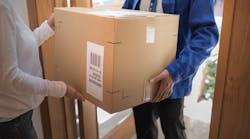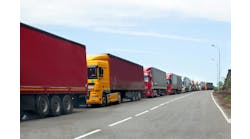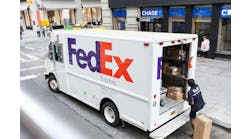Now is the time when many retailers are finalizing their order fulfillment plans for the holiday season. While buyers will have already placed their bets on this year’s must-have items, logistics teams are busy beefing up warehouse storage to ensure there is room for seasonal inventory, and implementing improvements to the last-mile delivery process to make sure they can confidently meet peak demands.
Last-mile fulfillment is no longer simply the concern of the transport department tasked with driving down fuel costs and increasing first-time delivery. Every department needs to take responsibility for the customer getting the best service, particularly as it is the final, and in some cases only, direct contact a retailer will have with its customer. Getting this critical touchpoint wrong could damage the overall brand experience and ultimately have dire consequences for customer satisfaction and loyalty. Never is this truer than during the holiday season.
What’s Right for your Customers?
While it is not necessary for everyone to match the Amazons and major supermarkets of this world, it is critical that retail organizations understand the expectations of their customers when it comes to delivery services. If, for example, a retailer is selling furniture, such as beds or sofas, it will take a very different approach than a clothes retailer in terms of doorstep experience, added-value features and returns.
It’s important to keep this in mind with seasonal promotions. If a retailer is offering a highly differentiated, white-glove delivery service, then it needs to consider how this can be scaled if peak demand results in double the usual number of deliveries. Can contract staff be trained to provide the same level of service? What KPIs can be put in place to ensure 3PLs or carriers deliver the same quality of service the private fleet achieves? When can last orders be taken without compromising the delivery promise?
With many B2C customers happy to quickly share their opinions on social media, a seasonal promotion that hasn’t been thought through could easily undermine a position in the market built on outstanding customer service.
Is It Possible to Make a Difference for the Holidays Now?
With the need to meet high customer service expectations and the holidays fast approaching, is it realistic to think that you can still impact this year’s fulfillment operation? Customers that have a bad experience with a brand when ordering holiday gifts for friends and family will not shop with a retailer again, so anything that can be done to improve the experience is vital.
If you are responsible for a distribution operation that peaks during the holiday season, here are a few points that you can consider to improve your performance this year:
1. Use historical data to plan ahead. A good place to start is by using historical data to create what-if scenarios. By modeling what would happen if additional vehicles and drivers were used for two weeks, or deliveries made during the evenings and weekends, it is possible to see what the impact on your home delivery service would be with the same volumes from last year, or a 10% increase in orders.
2. Make sure you have the right resources in place. Given the truck driver shortage across the U.S., it is important to maximize utilization of your drivers while ensuring the work is distributed evenly and drivers have a fair workload. Using historical data, you can also work out the number of drivers you will need when factoring in considerations like meal breaks, Hours-of-Service regulations and any installation skills required for your deliveries. If contracted staff drive up costs during peak time, then the ability to maximize utilization of existing staff will help you keep third-party costs to a minimum while ensuring you meet your delivery promises.
3. Only promise what can be achieved. According to the 2017 National Retail Federation Holiday Survey, over three-quarters of consumers say that they don’t feel pressured to shop early because they are confident that retailers will guarantee on-time delivery. There is enormous pressure to offer tight delivery time windows during the holiday season, but what’s really important is to deliver within the specified timeframe. Setting customer expectation correctly is crucial to this, so only offer feasible time windows that factor in all of the potential constraints. Examples include driver availability, deliveries in the same area, the time it takes to pick stock in the warehouse, or the time it takes to consolidate an order from multiple different depots before it leaves your distribution center.
4. Offer customers alternatives that remove the pressure on your delivery service. If your delivery operation has created a bottleneck in previous years, it might be worth incentivizing customers to pick up their orders from your stores. Click-and-collect at your own brick-and-mortar stores, or in conjunction with other non-competing retailers, could reduce the cost of your distribution considerably and may even be seen as a more convenient delivery option by many customers.
5. Get your returns process in shape. We know that an increasing number of customers won’t purchase from a retailer if they don’t like the look of their returns policy. A returns policy needs to encourage consumers to buy, but it also needs to be backed by a process that ensures goods are available for resale as quickly as possible. If returns aren’t tackled swiftly, then a large amount of expensive inventory is either lost or left sitting in the warehouse, without any means of showing that it is available for resell. Make sure you have a process in place that inserts inventory back into the system as quickly as possible.
Balancing Cost with Service
Customer experience needs to sit at the forefront of any home delivery strategy. It is about providing excellence throughout the fulfillment process in line with customer expectations, but not at the expense of profit. Even if a retailer attempting to buy market share with targeted delivery offers, it is not sustainable in the long term, so managing and controlling costs are essential. Everyone in a retail operation has a responsibility to improve margins and keep overheads to a minimum, but this has to be balanced with providing the best possible service for customers.
The last mile is typically the least efficient link in the supply chain, encompassing up to 28% of the total cost of delivery. There are a number of reasons for that. Many of these deliveries are made to consumers’ homes, which are often spread far and wide, adding mileage to the total cost and extending the timeframe. Plus, deliveries made in urban areas suffer from growing congestion, which can slow delivery times.
These factors are significantly compounded if the customer isn’t home to accept it, or the business you are delivering to doesn’t have the right equipment to unload the order. So how can you improve first-time delivery success? Here are a few ideas:
1. Allow customers to choose their own delivery windows. Retail customers say that letting consumers select their own delivery windows increases the success of first-time delivery. Displaying a range of time windows on your website at the point of purchase allows the customer to check somebody is going to be home before going ahead with placing their order.
2. Allow your customers to change their time window. Allowing customers to self-serve and change their delivery up until the day of delivery puts the customer in control and increases the chance of first-time delivery success.
3. Continuous communication. Provide updates via SMS or e-mail throughout the order lifecycle so that the customer is kept up to date with the progress of their order, and has the opportunity to amend their time window at every step. This will reduce the volume of inbound calls to your customer services team and increase the confidence the customer has in your delivery service.
4. Use automated customer notifications on the day of delivery. Messages triggered by the driver leaving the depot, or the successful completion of the previous job can all help increase the chances of the customer being there when your driver arrives. For example, self-service text capability means customers can receive updates on the day of delivery from drivers, saying, “We are 30 minutes away. Are we still okay with this delivery time?” If the customer is stuck in traffic, they can choose a later time slot, ensuring they will be home for the delivery.
Supply chain and technology innovations are driving the introduction and wider adoption of new services, with greater visibility and control, enabling later cut-off points and timed slots to be provided cost-efficiently. Order fulfillment systems are also allowing retailers to meet consumer demand for alternative delivery locations by bringing together home delivery requirements with click-and-collect, locker and parcel options.
If you are looking to introduce a much more service-led fulfillment solution ready for the holidays, some level of technology investment may be unavoidable, but this is not to say you cannot enhance your offering while keeping added overheads to a minimum. Excellent service typically goes hand-in-hand with high levels of efficiency, so there are often savings created that can offset a proportion of any added investment. Creating a seamless and integrated experience across all channels helps to optimize resources, which in turn supports an affordable and realistic fulfillment solution. MH&L
William Salter is CEO and president of Paragon Software Systems, a provider of truck routing and scheduling software solutions.



